Amyloidosis
Pairs:
spleen - liver
spleen - spleen

Generalities:
Amyloidosis is a rare disease and is caused by a problem in the metabolism of amyloid protein . This type of protein is made in the bone marrow, so it participates in the production of antibodies. When it cannot be metabolized correctly, it begins to accumulate in various organs and tissues, causing various disorders. The life prognosis (for allopathy) is 1 - 4 years. Cardiac complications and kidney failure, added to underlying disorders, are often the causes of death.
Symtoms:
The disease progresses slowly, most of the time without a correct diagnosis. When it reaches advanced stages, it can present various symptoms:
- Severe fatigue and weakness
- Swelling of the legs and ankles
- Nervous system disorders: numbness in the extremities and ankles
- Respiratory system disorders: shortness of breath
- Digestive disorders: diarrhea
- Liver disorders: hepatomegaly
- Enlarged tongue and swallowing difficulty
- Alterations in the skin: thickening, spots, etc.
- Cardiovascular disorders: arrhythmia
- Kidney failure, as a serious complication of the disease.
Causes:
Although there are several hereditary factors, above all it is a disease that we could consider of a chronic-degenerative type. Let's look at some of the risk factors.
- Age, more common in adults.
- Sex, 70% of persons affected are men.
- Family history can favor its incidence. Certain genes can cause the disease.
- Kidney dialysis increases the risk of developing the disease
- Chronic infections or inflammatory disorders such as rheumatoid arthritis
- Race: African races are more prone to developing cariac-type complications.
Treatment:
As we have already mentioned, hereditary factors are important, but amyloidosis is mainly due to hormonal and metabolic alterations, which together with a chronic inflammatory condition cause a disorder in protein metabolism. Fortunately, biomagnetism has found a relationship between this disorder and disorders in the spleen and liver. Since it is a complex disease, it is important to carry out a thorough screening to be able to find the associated pairs, and the corresponding pathogens; without overlooking hormonal or psycho-emotional disorders that may be underlying.